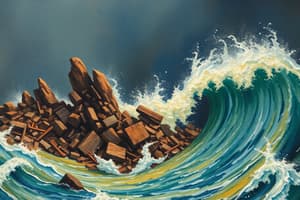Podcast
Questions and Answers
What primary mechanism causes a tsunami following an earthquake?
What primary mechanism causes a tsunami following an earthquake?
- Vertical displacement of the seafloor during the earthquake. (correct)
- The earthquake's seismic waves directly impacting coastal structures.
- The release of methane hydrates from the seafloor increasing water volume.
- Large-scale landslides triggered by the earthquake.
Why do tsunamis increase in height as they approach coastal areas?
Why do tsunamis increase in height as they approach coastal areas?
- Increased gravitational pull from coastal landmasses draws water towards the shore.
- The wavelength decreases, causing the wave's energy to compress into a smaller volume. (correct)
- The Earth's magnetic field interacts more strongly with the water near coastlines.
- The wind's effect on the water surface becomes more pronounced near the coast.
Which type of fault movement is most likely to generate a tsunami-causing earthquake?
Which type of fault movement is most likely to generate a tsunami-causing earthquake?
- Strike-slip fault, where plates slide horizontally past each other.
- Normal fault, where the hanging wall moves down relative to the footwall.
- Transform fault, where the movement is primarily rotational.
- Reverse/Thrust fault, where the hanging wall moves up relative to the footwall. (correct)
How does the depth of the ocean affect the speed and height of a tsunami?
How does the depth of the ocean affect the speed and height of a tsunami?
Why are coastal communities with gently sloping shorelines more vulnerable to tsunami devastation?
Why are coastal communities with gently sloping shorelines more vulnerable to tsunami devastation?
What role do subduction zones play in the generation of tsunami-causing earthquakes?
What role do subduction zones play in the generation of tsunami-causing earthquakes?
Which of the following factors does NOT influence the extent of devastation caused by a tsunami on a coastal community?
Which of the following factors does NOT influence the extent of devastation caused by a tsunami on a coastal community?
How do early warning systems help mitigate the impact of tsunamis on coastal communities?
How do early warning systems help mitigate the impact of tsunamis on coastal communities?
What is the primary difference between a local tsunami and a distant (or teletsunami)?
What is the primary difference between a local tsunami and a distant (or teletsunami)?
Which of the following strategies is LEAST effective in reducing the devastating impact of tsunamis on coastal communities?
Which of the following strategies is LEAST effective in reducing the devastating impact of tsunamis on coastal communities?
Flashcards
Earthquake-induced Tsunamis
Earthquake-induced Tsunamis
Earthquakes, especially those occurring under the ocean floor, can cause tsunamis by suddenly displacing large volumes of water. This displacement generates powerful waves that radiate outwards from the epicenter. As these waves approach shallower coastal waters, their speed decreases, but their height dramatically increases, leading to devastating flooding and destruction upon reaching shoreline communities.
Subduction Zone Tsunamis
Subduction Zone Tsunamis
Subduction zones, where one tectonic plate slides beneath another, are common sites for large earthquakes. These earthquakes can trigger tsunamis if the rupture zone involves vertical displacement of the seafloor. The sudden uplift or subsidence of the seabed transfers energy to the water column above, initiating a series of tsunami waves.
Tsunami Wave Energy
Tsunami Wave Energy
The immense energy of a tsunami is due to its long wavelength and the entire depth of the ocean being in motion. In the open ocean, a tsunami wave may be only a few feet high but hundreds of kilometers long, traveling at jet aircraft speeds. Upon reaching shallower coastal waters, the wave's energy is compressed, causing the wave height to increase dramatically.
Coastal Tsunami Vulnerability
Coastal Tsunami Vulnerability
Signup and view all the flashcards
Other Tsunami Causes
Other Tsunami Causes
Signup and view all the flashcards
Study Notes
- Earthquakes can cause tsunamis, which are a series of powerful ocean waves that can devastate shoreline communities.
- Tsunamis are most commonly generated by undersea earthquakes, especially those occurring at subduction zones.
- The magnitude, depth, and location of an earthquake are critical factors in determining whether it will generate a tsunami.
Earthquake-Tsunami Mechanism
- When an earthquake occurs beneath the ocean floor, it can cause a sudden vertical displacement of the seabed.
- This displacement can be caused by the rupture of a fault line, where one block of the Earth's crust moves vertically relative to another.
- If the earthquake is of sufficient magnitude (typically greater than 7.0) and the displacement is significant, it can generate a tsunami.
- The vertical displacement of the seabed abruptly pushes a large volume of water upwards, creating a wave.
- Conversely, a downward movement of the seabed pulls water downwards.
- This initial disturbance propagates outwards in all directions as a series of waves.
- In the open ocean, tsunami waves have long wavelengths (often hundreds of kilometers) and relatively small amplitudes (less than a meter).
- This means they can travel at high speeds (500-1,000 km/h) and are often unnoticed by ships.
- As the tsunami approaches shallower coastal waters, its behavior changes dramatically.
- The wave's speed decreases due to friction with the seabed.
- The wavelength shortens, and the amplitude (height) increases significantly.
- This "shoaling" effect can cause the tsunami wave to grow to several meters or even tens of meters in height as it nears the shore.
- When the tsunami reaches the coastline, it can cause immense destruction.
- The large mass of water surges inland, flooding coastal areas and destroying buildings, infrastructure, and vegetation.
- The force of the water can also erode the coastline, uproot trees, and carry debris inland.
- Tsunamis often arrive as a series of waves, with the first wave not necessarily being the largest.
- The time between successive waves can range from minutes to hours.
- This can lull people into a false sense of security after the initial wave, leading them to return to the affected area before subsequent, potentially larger, waves arrive.
Impact on Shoreline Communities
- Tsunamis can have devastating impacts on shoreline communities, causing widespread destruction and loss of life.
- The initial surge of water can inundate coastal areas, flooding homes, businesses, and infrastructure.
- The force of the water can destroy buildings, bridges, and roads, leaving communities isolated and without essential services.
- Tsunami waves can also carry debris, such as boats, cars, and trees, which can cause further damage and injury.
- In addition to the immediate destruction, tsunamis can have long-term impacts on shoreline communities.
- Saltwater intrusion can contaminate freshwater sources and agricultural land, making it difficult to grow crops or obtain potable water.
- The destruction of infrastructure can disrupt transportation, communication, and commerce, hindering recovery efforts.
- The psychological impact of a tsunami can be significant, with survivors experiencing trauma, anxiety, and grief.
- Coastal communities that have experienced tsunamis often require extensive rebuilding and recovery efforts.
- This can involve repairing or replacing damaged infrastructure, restoring essential services, and providing support to affected populations.
- Tsunami warning systems play a crucial role in mitigating the impact of these events.
- These systems use seismic sensors and sea-level gauges to detect earthquakes and tsunami waves.
- When a tsunami is detected, warnings are issued to coastal communities, giving people time to evacuate to higher ground.
- Education and awareness programs are also important for preparing coastal communities for tsunamis.
- These programs teach people about the risks of tsunamis, how to recognize warning signs, and what to do in the event of a tsunami.
- Coastal land-use planning can also help to reduce the vulnerability of shoreline communities to tsunamis.
- This can involve restricting development in low-lying areas, building seawalls and other protective structures, and preserving natural coastal barriers such as mangrove forests.
Studying That Suits You
Use AI to generate personalized quizzes and flashcards to suit your learning preferences.





